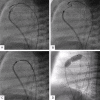Optimal management of pulmonary atresia with intact ventricular septum in a developing country: the art of pulmonary valve mechanical perforation in the era of CTO hardware
- PMID: 33815916
- PMCID: PMC8012288
Optimal management of pulmonary atresia with intact ventricular septum in a developing country: the art of pulmonary valve mechanical perforation in the era of CTO hardware
Abstract
Background: Transcatheter valve mechanical perforation (TVMP) in pulmonary atresia with intact ventricular septum (PAIVS) is an acceptable yet challenging alternative to radiofrequency.
Aims: To evaluate and compare safety, feasibility, and efficiency of two TVMP techniques.
Methods: Clinical data of neonates with PAIVS who underwent an attempt for TVMP between 2009 and 2019 were retrospectively reviewed. Patients were divided into two groups according to perforation technique: using the stiff end of a percutaneous transluminal coronary angioplasty (PTCA) ordinary 0.014" wire (group A) and subsequently with the floppy tip of a chronic total occlusion (CTO) guidewire (group B). The technical aspects, procedural and discharge outcomes of both groups were compared.
Results: A total of 19 antegrade TVMP procedures (Group A, n=10, and Group B, n=9) were attempted in 18 neonates with an overall success rate of 73.7% and no procedure-related mortality. Groups' analysis showed that the introduction of CTO hardware maximized procedure success rates (P=0.002) with zero failure and misperforations (P=0.022). The significant drop in perforation time (P < 0.001) and irradiation exposure (P=0.006) allowed additional ductal stenting during the same procedure, optimizing patients' clinical outcomes and shortening overall hospital stay. Discharged patients had room air mean oxygen saturation of 91.4% (± 5.5) with no evidence of heart failure.
Conclusions: In selected cases of PAIVS, TVMP using CTO wires is a safer, highly efficient, and simplified alternative to other mechanical perforation techniques. It substantially revolutionized the management of PAIVS in our center optimizing short-term prognosis.
Keywords: Pulmonary atresia; cardiac catheterization; chronic total occlusion; guidewire; mechanical perforation.
AJCD Copyright © 2021.
Conflict of interest statement
Z. Saliba is a proctor and consultant for Abbott Vascular since 2017. R. Haddad has no conflict of interest to declare.
Figures



Similar articles
-
Transcatheter perforation of atretic pulmonary valve by the stiff end of a coronary wire in neonates with pulmonary atresia with intact ventricular septum: A solution in developing countries.J Saudi Heart Assoc. 2018 Jul;30(3):222-232. doi: 10.1016/j.jsha.2018.01.002. Epub 2018 Jan 31. J Saudi Heart Assoc. 2018. PMID: 29989054 Free PMC article.
-
Transcatheter pulmonary valve perforation using chronic total occlusion wire in pulmonary atresia with intact ventricular septum.Ann Pediatr Cardiol. 2017 Jan-Apr;10(1):5-10. doi: 10.4103/0974-2069.197065. Ann Pediatr Cardiol. 2017. PMID: 28163422 Free PMC article.
-
The Use of Chronic Total Occlusion (CTO) Wires for Perforation of Atretic Pulmonary Valve; Two Centers Experience.Pediatr Cardiol. 2021 Jun;42(5):1041-1048. doi: 10.1007/s00246-021-02578-1. Epub 2021 Apr 12. Pediatr Cardiol. 2021. PMID: 33844078
-
Guiding Principles for Chronic Total Occlusion Percutaneous Coronary Intervention.Circulation. 2019 Jul 30;140(5):420-433. doi: 10.1161/CIRCULATIONAHA.119.039797. Epub 2019 Jul 29. Circulation. 2019. PMID: 31356129 Review.
-
Intervention in the critically ill neonate and infant with hypoplastic left heart syndrome and intact atrial septum.J Interv Cardiol. 2001 Jun;14(3):357-66. doi: 10.1111/j.1540-8183.2001.tb00345.x. J Interv Cardiol. 2001. PMID: 12053397 Review.
Cited by
-
Impact of Drug Elution on Infectious Outcomes after Ductal Stenting in Newborns.Pediatr Cardiol. 2024 Sep 5. doi: 10.1007/s00246-024-03625-3. Online ahead of print. Pediatr Cardiol. 2024. PMID: 39231824
-
Pulmonary Atresia with Intact Ventricular Septum, a National Comparison Between Interventional and Surgical Approach, in Combination with a Systemic Literature Review.Pediatr Cardiol. 2025 Aug;46(6):1523-1536. doi: 10.1007/s00246-024-03566-x. Epub 2024 Jul 5. Pediatr Cardiol. 2025. PMID: 38967792 Free PMC article.
References
-
- Alwi M. Management algorithm in pulmonary atresia with intact ventricular septum. Catheter Cardiovasc Interv. 2006;67:679–686. - PubMed
-
- Haddad RN, Hanna N, Charbel R, Daou L, Chehab G, Saliba Z. Ductal stenting to improve pulmonary blood flow in pulmonary atresia with intact ventricular septum and critical pulmonary stenosis after balloon valvuloplasty. Cardiol Young. 2019;29:492–498. - PubMed
-
- Rathgeber S, Auld B, Duncombe S, Hosking MC, Harris KC. Outcomes of radiofrequency perforation for pulmonary atresia and intact ventricular septum: a single-centre experience. Pediatr Cardiol. 2017;38:170–175. - PubMed
-
- Walsh MA, Lee KJ, Chaturvedi R, Van Arsdell GS, Benson LN. Radiofrequency perforation of the right ventricular outflow tract as a palliative strategy for pulmonary atresia with ventricular septal defect. Catheter Cardiovasc Interv. 2007;69:1015–1020. - PubMed
-
- Alwi M, Geetha K, Bilkis AA, Lim MK, Hasri S, Haifa AL, Sallehudin A, Zambahari R. Pulmonary atresia with intact ventricular septum percutaneous radiofrequency-assisted valvotomy and balloon dilation versus surgical valvotomy and Blalock Taussig shunt. J Am Coll Cardiol. 2000;35:468–476. - PubMed
LinkOut - more resources
Full Text Sources
